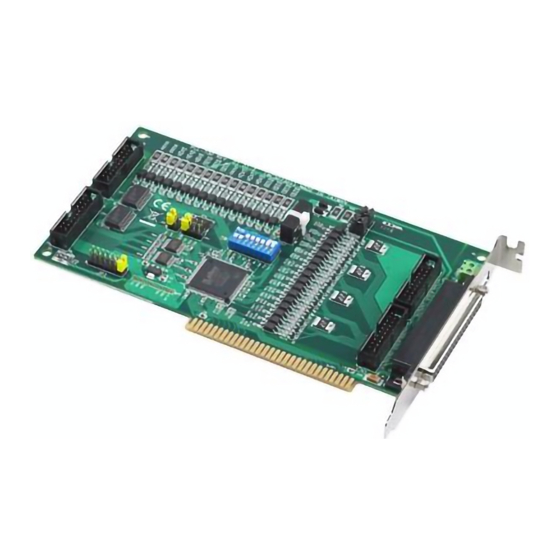Table of Contents
Advertisement
Quick Links
PCL-730
32-channel Isolated I/O Card
Packing List
Before installation, please make sure that you have
received the following:
• PCL-730
• Driver CD
• Quick Start User Manual
If anything is missing or damaged, contact your dis-
tributor or sales representative immediately.
User Manual
For more detailed information on this product, please
refer to the PCL-730 User Manual on the CD-ROM
(PDF format).
CD:\Documents\Hardware Manuals\PCL\PCL-730
Declaration of Conformity
FCC Class A
This equipment has been tested and found to comply with
the limits for a Class A digital device, pursuant to part 15 of
the FCC Rules. These limits are designed to provide reason-
able protection against harmful interference when the equip-
ment is operated in a commercial environment. This
equipment generates, uses, and can radiate radio frequency
energy and, if not installed and used in accordance with the
instruction manual, may cause harmful interference to radio
communications. Operation of this equipment in a residen-
tial area is likely to cause interference in which case the user
is required to correct interference at his own expense.
CE
This product has passed the CE test for environmental speci-
fications when shielded cables are used for external wiring.
We recommend the use of shielded cables. This kind of cable
is available from Advantech. Please contact your local sup-
plier for ordering information.
Overview
The Advantech PCL-730 offers 32 isolated digital I/O chan-
nels (16 DI and 16 DO) and 32 TTL digital I/O channels (16
DI and 16 DO) on a PC addon card. Providing 2500 V isola-
tion, each I/O channel corresponds to a bit in a PC I/O port,
making the PCL-730 very easy to program. The PCL-730
offers one PC interrupt with jumper-selectable IRQ..
Notes
For more information on this and other Advantech prod-
ucts, please visit our websites at:
http://www.advantech.com/eAutomation
For technical support and service:
http://www.advantech.com/support/
This startup manual is for PCL-730
Part No.2003730060
1
Startup Manual
Software Installation
Hardware Installation
1. 1. Turn off your computer and unplug the power
cord and cables. TURN OFF your computer
before installing or removing any components on
the computer.
2. Remove the cover of your computer.
3. Remove the slot cover on the back panel of your
computer.
4. Touch the metal part on the surface of your com-
puter to neutralize the static electricity that might
be on your body.
5. Insert the PCL-730 card into an ISA slot. Hold the
card only by its edges and carefully align it with
the slot. Insert the card firmly into place. Use of
1st Edition
excessive force must be avoided; otherwise, the
June 2011
card might be damaged.
Advertisement
Table of Contents

Summary of Contents for Advantech PCL-730
- Page 1 For technical support and service: 5. Insert the PCL-730 card into an ISA slot. Hold the http://www.advantech.com/support/ card only by its edges and carefully align it with This startup manual is for PCL-730 the slot.
- Page 2 6. Fasten the bracket of the PCL-730 card on the back panel rail of the computer with screws. 7. Connect appropriate accessories (37-pin cable, wiring terminals, etc. if necessary) to the PCL-730 card. 8. Replace the cover of your computer chassis. Re-con- nect the cables you removed in step 2.
- Page 3 Hex 3F0. Other devices in your system may, however, be using some of these addresses. We set the PCL-730 for a base address of Hex 300 at the factory. If you need to adjust it to some other Interrupt source (JP3) address range, set switch SW1 as shown in the follow- Jumper JP3 selects the source of the card's interrupt.
- Page 4 EI.GND2.) The following figure shows how to connect an external input source to the card's isolated inputs: Signal Connections TTL-level I/O The PCL-730 has 16 TTL-level digital inputs and 16 TTL-level digital outputs. The following figure shows Isolated Output connections to exchange digital signals with other TTL...












Need help?
Do you have a question about the PCL-730 and is the answer not in the manual?
Questions and answers